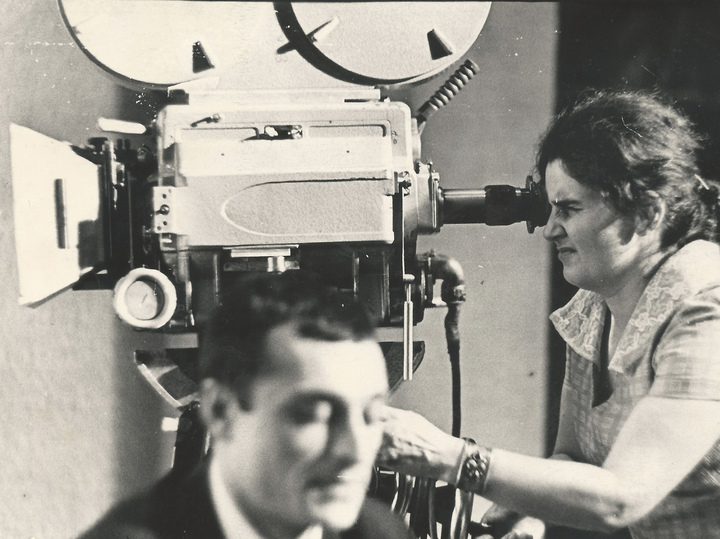Films about the Soviet past and the ghostliness of architecture and concrete were shown at the Berlinale
[ad_1]
Documentary films at the festival: a European project by a Russian director and a Georgian view of the USSR
On February 24, the 74th Berlin Film Festival will announce its winners. In its main competition, the premiere of the French-German documentary film “Architecton” took place, shot by Russian director Viktor Kosakovsky, who has lived in Spain for many years. Soviet-Georgian director Lana Gogoberidze is participating in the Forum Special program with the autobiographical non-fiction film “Mother-Daughter”.
“Architecton” is one of 20 films in the main Berlinale competition. It features only two non-fiction films – also “Dahomey” by the French-Senegalese director Mati Diop. It tells how France returns to its former colony in West Africa exported works of art from the kingdom of Dahomey, which existed in what is now Benin.
Kossakovsky’s new film was the final part of the “Empathy” trilogy that spanned a whole decade. Victor rarely films because he has large-scale projects related to complex geography and requiring a lot of funding, which he never received while living in St. Petersburg. The first part of the trilogy “Long live the Antipodes!” opened the 2011 Venice Film Festival. The world premiere of “Watercolor” in 2018 also took place in Venice – for the first time in history, Kossakovsky’s film had not 24 frames per second, but 96. The second film of the trilogy became a hymn to water, before the elements and power of which man is helpless. Nature takes revenge on him for his arrogance.
The final “Architecton” is a symphony about the fragility of the world, the destruction of civilization using the example of architecture, which is especially vulnerable during modern cataclysms. It is destroyed by natural elements and humans. Ancient architecture miraculously survives, but modern architecture disappears because it is made of concrete. For his sake, mountains are blown up, so that flying stones sweep away everything in their path. They are processed into concrete, and new dull structures will soon “decorate” the Earth. The 2023 earthquake in Turkey destroyed hundreds of concrete houses. Their wreckage is taken away to once again be used for the construction of equally faded buildings. But the graceful Greek columns, the Temple of Jupiter in the Lebanese Baalbek, built by the ancient Romans, still stand, striking in their grandeur and beauty.
The title of the film refers to the definition of Kazemir Malevich. His suprematist plaster model “Architecton “Alpha”” from 1920 is on display in the Benois building of the Russian Museum in St. Petersburg. For Malevich this is an architectural formula for new forms. Its geometric shapes seemed to crash into each other. Malevich is the author of a dozen architects made of cardboard, plaster and wood. He considered his works as models of space structures that in the near future could be used in the space industry, and people would live on such stations. Malevich’s architects, according to the Swiss-French architect Le Corbusier, influence the viewer’s feelings, evoking aesthetic emotions, introducing them to the comprehension of the harmony of the world and the knowledge of beauty. Viktor Kosakovsky is moving in the same direction. His film crossed the usual boundaries of documentary.
In addition to the director, Architecton was represented at the festival by the Italian architect Michele de Lucchi, who became the hero of the film. The screen shows the stone circle he built in his garden. A person cannot enter it. But the road is open to dogs and horses. According to the director, man is part of nature, but there are places where he is prohibited from entering. The music for the film was written by composer Evgeny Galperin, who has lived in France for a long time. He also took part in the press conference and presented the film.
The Forum Special program includes three screenings of the documentary film “Mother-Daughter” by a 95-year-old classic of Soviet and Georgian cinema, directed by Lana Gogoberidze. Two screenings have already taken place, the last one is scheduled for the final day of the Berlinale, but tickets have long been sold out.

Lana Gogoberidze graduated from the workshop of Sergei Gerasimov and Tamara Makarova at VGIK in 1953, made the films “Under the Same Sky” (debut), “I See the Sun”, “Waltz on Petchor”, “A Day is Longer than Night”, “Trouble”, “Several interview on personal issues” with Sofiko Chiaureli in the title role. Her films have been shown at the Cannes and Venice Film Festivals. In 1984, Lana Gogoberidze was a member of the jury of the 34th Berlinale.
Her father was arrested in 1937 and shot. Her mother, Nutse Gogoberidze, became one of the first Soviet women directors and the first woman director in Georgia. At the age of 25, Nutse made her debut film “Their Kingdom.” Soon her film career ended. After the arrest and death of her husband, she spent ten years in the Gulag as “a member of the family of a traitor to the motherland.” After her release, Nutsa Gogoberidze was engaged in translating European fairy tales into Georgian. Lana Gogoberidze also translated the poetry of Akhmatova, Tsvetaeva, Pasternak, Brodsky, Akhmadulina into Georgian, and was involved in translations of French poetry. Even before entering VGIK, she graduated from the philological department of Tbilisi University, and later defended her dissertation. For a short time she studied with Georgiy Tovstonogov at the Tbilisi Theater Institute, until he left Tbilisi.

Lana Gogoberidze made the film “Mother-Daughter” about the tragic life of her mother and partly about her own, which occurred during Stalin’s time and the war years. Her own daughter and director Salome Alexi (Nutsa Alexi-Meskhishvili) helped her in this. Lana Gogoberidze traveled back in time and talked about strong and free women whose lives fell on difficult times. She found her mother’s films in the film archives, unique and once prohibited materials, which were partially included in the film “Mother-Daughter”.
[ad_2]
Source link






